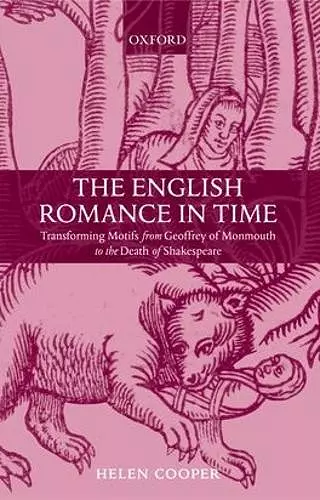The English Romance in Time
Transforming Motifs from Geoffrey of Monmouth to the Death of Shakespeare
Format:Hardback
Publisher:Oxford University Press
Published:17th Jun '04
Currently unavailable, and unfortunately no date known when it will be back
This hardback is available in another edition too:
- Paperback£62.00(9780199532582)

This book is a study of English romance across the Middle Ages and the Renaissance. It explores romance motifs - quests and fairy mistresses, passionate heroines and rudderless boats and missing heirs - from the first emergence of the genre in French and Anglo-Norman in the twelfth century down to the early seventeenth. This is a continuous story, since the same romances that constituted the largest and most sophisticated body of secular fiction in the Middle Ages went on to enjoy a new and vibrant popularity at all social levels in black-letter prints as the pulp fiction of the Tudor age. This embedded culture was reworked for political and Reformation propaganda and for the 'writing of England', as well as providing a generous reservoir of good stories and dramatic plots. The different ways in which the same texts were read over several centuries, or the same motifs shifted meaning as understanding and usage altered, provide a revealing and sensitive measure of historical and cultural change. The book accordingly looks at those processes of change as well as at how the motifs themselves work, to offer a historical semantics of the language of romance conventions. It also looks at how politics and romance intersect - the point where romance comes true. The historicizing of the study of literature is belatedly leading to a wider recognition that the early modern world is built on medieval foundations. This book explores both the foundations and the building. Similarly, generic theory, which previously tended to operate on transhistorical assumptions, is now acknowledging that genre interacts crucially with cultural context - with changing audiences and ideologies and means of dissemination. The generation into which Spenser and Shakespeare were born was the last to be brought up on a wide range of medieval romances in their original forms, and they could therefore exploit their generic codings in new texts aimed at both elite and popular audiences. Romance may since then have lost much of its cultural centrality, but the universal appeal of these same stories has continued to fuel later works from Bunyan's Pilgrim's Progress to C.S. Lewis and Tolkien.
In its erudition, thoroughness, fidelity to its subject, and its lucidity, Helen Cooper's is the best book on romance that has yet been written, and it is hard to conceive a better. * R. S. White, Yearbook of English Studies *
a book well stocked with information and generously peppered throughout with humorous analogy. * Tiffany Alkan, Reformation *
...this book is gracefully written with clarity and precision and has been carefully edited ... The English Romance in Time is a major contribution that will have long-lasting influence and probably become a reference book ... this book deserves a place in our libraries. * Jordi Sanchez-Marti, Atlantis *
The English Romance in Time is a scholarly and engagingly written account of a genre, as suitable for a student as for and academic audience. It is important and innovative because of the way it uses romance to expose the medieval contribution to the early modern world. * Times Higher Education Supplement *
... impressive study ... Cooper's learned but very readable volume is made even more useful by the well-organized appendix ... in every section illuminating insights are offered into structural patterns and thematic variations, links between history and romance, and Early Modern responses to medieval texts, along with many delightful snippets of esoteric information and well-turned phrases ... Helen Cooper's range is impressively wide; she wears her learning lightly, and sprinkles her arguments with delightful asides. * Elizabeth Archibald, Times Literary Supplement *
ISBN: 9780199248865
Dimensions: 224mm x 148mm x 35mm
Weight: 806g
560 pages